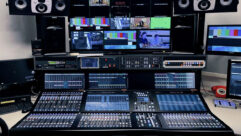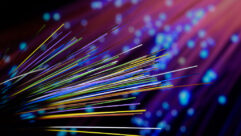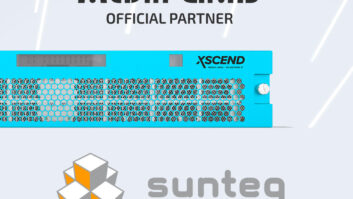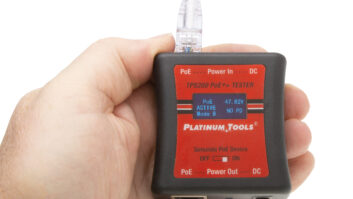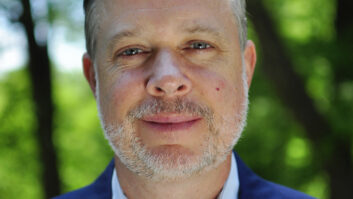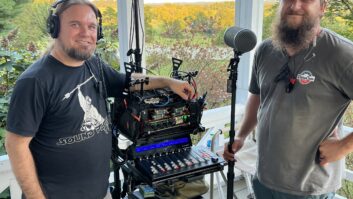
Expert Roundtable: The State of Fiber
Mar 1, 2009 12:00 PM,
By Bennett Liles
Four industry experts shed some light on the future of fiber.

One of the most venerable yet dynamic areas of the AV industry is fiber optics, with a sustained growth rate spurred by growing bandwidth needs, more training opportunities, and tougher hardware. In many quarters, fiber has consolidated its position as a preferred signal-transmission medium.
SVC recently assembled a group of fiber-optic industry experts to get their thoughts on the current state of the industry and to offer some insight as to where fiber is headed on what has become an increasingly complicated landscape. Those experts are Joe Commare, VP of marketing and international sales for Telecast Fiber (www.telecast-fiber.com); Sam Spennacchio, director of sales and marketing for FiberPlex (www.fiberplex.com); Jim Hayes, president of the Fiber Optic Association (www.thefoa.org); and John Lopinto, president and CEO of CSI (www.commspecial.com). Here, they offer their opinions about fiber’s rollout, current direction, and future.
SVC: How would you rate the acceptance level of fiber-optic gear as being roadworthy and easy enough to terminate for field use?
Commare: As with any new technology, there was early resistance. It looked different. It worked differently. It required active components on each end. But as the technology advanced and we came up with more robust cables and better connectors, fiber was accepted. By the time HD started coming around, engineers realized that they had better get some experience with fiber or else be left behind.
Spennacchio: There are some that are still leery, but most customers are coming around. Most companies using tactical fiber for live production do not have someone on staff capable of terminating a military-grade tactical connector onsite. They simply carry spare fiber. As far as installations, more companies need to get their people trained to terminate simple LC, ST, etc. connectors. That said, FiberPlex provides most customers with pre-terminated fiber containing a pulling eye on one end. The integrator simply pulls the fiber and connects it at each end.
As far as being roadworthy, every live sports broadcast outfit I know of [has been doing] audio, video, and intercom almost exclusively over fiber for some years now. Thunder Audio, [located in Taylor, Mich.] — which is the sound company for the current [European] Metallica tour — purchased a 96-channel LightViper system, which is being used as a drive snake for 200 self-powered speakers in the round.
Hayes: That question is so last-century. About 25 years ago, most people learned about fiber from Ph.D.s at AT&T, which did most of the installs too. Now, the majority of security, sound and video, and electrical contractors we know do plenty of fiber-optic installations. Back then, every article about fiber began with, “It is made of glass, so it’s fragile, it’s hard to terminate, and it’s too expensive.” Well, it was never fragile — remember it’s glass that provides strength to fiberglass boats — and termination has become easier than many copper connectors.
As for price, it’s now competitive with copper for most applications — even less for many applications like fiber to the home — when one considers the lower maintenance costs and lack of obsolescence or 10G data centers where the lower power consumption is what matters.
Expert Roundtable: The State of Fiber
Mar 1, 2009 12:00 PM,
By Bennett Liles
Four industry experts shed some light on the future of fiber.

If fiber has an Achilles’ heel, it’s dirt. Fiber connections must be carefully cleaned with alcohol pads to protect connections from contamination. A dirty connector is the main cause of problems during installation and over time.
Lopinto: I think the perception is worse than the reality. There are some very good and easy-to-use products available. But the end users and resellers, for the most part, still have a toxic combination of paranoia and ignorance about the practical side of working with fiber cable and the gear itself.
In fairness, the products of 10 years ago weren’t very user-friendly nor of the caliber of performance required of the AV industry. But all that has changed. However, the AV industry continues to promote copper as the preferred media of choice, so it is very difficult to get the message through when most everyone dismisses it outright.
Related Links

Installation Trends: Expanding Worship
Greg Baker’s journey at Saddleback Church began in 1992 when he started attending services at the Lake Forest, Calif., facility, and…

Shownotes: Security and Control Over Fiber
S.I. Tech’s President and CEO, Ramesh Sheth, discusses the latest trends in fiber optics for video transmission and offers some insight from the inside of the industry in the field of security and transmission of control signals over fiber…

So many forces are driving the fiber market up that its rapid rise threatens to outpace the general understanding of its basic workings on the part of…
How do you see the status of fiber training in the United States and elsewhere? Where do you think the United States stands on fiber training compared to other industrialized nations?
Commare: Training is available through numerous outlets to anyone who wants it … from free online tutorials to organizations like the Light Brigade [a leading fiber-optic training company]. Here at Telecast, we have always had an open door to anyone who wants to make the trip to Worcester, [Mass]. We offer training on our gear at no cost.
Spennacchio: It’s still far from where it needs to be, but organizations such as InfoComm, NSCA, and others are stepping up with training, so it won’t be long before terminating, pulling, and dealing with fiber optics in general are as commonplace as soldering an XLR connector. In my opinion, the U.S. is neither leading nor lagging behind in this respect.
Hayes: As the Fiber Optic Association (FOA) — the professional society of fiber optics — we cover the world and have approved schools in almost 20 countries. Our experience is nobody has the variety and quality of fiber training comparable to the U.S. The FOA has over 200 FOA-approved schools that have certified over 25,000 techs. About 90 percent of our CFOTs [Certified Fiber Optic Technicians] are in the U.S. or Canada. Most FOA schools are independent, although several major companies now use our programs because of the recognition our certifications have with users.
Outside the U.S. — perhaps with the exception of the U.K. — much of the training is vendor-specific and done by the vendor themselves, which limits its applicability in an open marketplace. In order to reach more people around the world wanting to learn about fiber, the FOA has created a new, comprehensive reference website for fiber optics (www.thefoa.org/tech/ref) that will allow anyone, anywhere to learn about fiber from a reliable source — and it’s free.
Lopinto: The training for fiber technology for AV and broadcast applications is pathetically lacking in the U.S. We give fiber-optic technology training in company- and industry-sponsored seminars all over the world, and it constantly amazes us how poorly the U.S. seminars are attended and how overwhelming the response is in Asia and Europe. We teach the same seminars, same applications, same industries, and the same technology. I think U.S.-based end users and system integrators are complacent with the status quo and are only looking to new technologies like fiber when pushed to do it for competitive reasons, even though there may be valid economic and technical reasons to at least learn about it now.
Expert Roundtable: The State of Fiber
Mar 1, 2009 12:00 PM,
By Bennett Liles
Four industry experts shed some light on the future of fiber.
Where do you see the relative costs of fiber and copper cable and other hardware headed in relation to each other?
Commare: Raw copper has gotten pricey over the last few years. Bought any plumbing supplies lately? In terms of cable, there is little difference in installing one or the other. Since the technology is always advancing (analog video to HD video and now on the 3Gbps 1080p signals), we do not see price reductions in hardware (transmitters and receivers), because they are doing more at faster speeds now than even just two years ago. Prices have come down on raw optical components significantly.
Spennacchio: Well, for a while there, the price of copper was soaring. Now, like other commodities, the price has been going down. The real savings with fiber versus copper, regardless of the initial cost of the cable, is the significant reduction in onsite labor for installed systems and the significant reduction in weight, space, and time (setup and teardown) savings for live concert sound or broadcast production use.
Hayes: It’s really more a distance/bandwidth issue as prices are usually comparable. CCTV, for example, uses fiber because coax has such a limited distance capability, and data centers use fiber because at 10Gbps, copper has distance/bandwidth problems while fiber is just cruising. The unexpected advantage of fiber at 10G is power consumption — a big issue as servers consume about 2 percent of all power in the U.S.
Lopinto: Fiber cable in the U.S. has more or less reached a plateau at about 2 cents a foot less than Cat-5e. Copper cable, on the other hand, seems to have an upward bias in pricing. The real problem with copper pricing is when you price it versus the bandwidth that is required for an application. Cat-5e used to be sufficient for most all applications when all you were transmitting was XGA resolutions. But now, support for WUXGA, 1080p, and 2K resolutions is becoming more than norm — which pushes up the need for higher-bandwidth copper cabling, such as Cat-6, Cat-7, and in some cases, even multiple coax. Now, when you compare the cost of fiber versus copper, it isn’t even close. People need to understand that the cost of one transmission media versus another is all about bandwidth, not the raw per-foot cost.
Are there any recent developments in fiber cable or transmission equipment that look promising? (Such as bend radius, transmission distance, multiplexing, and so on.)
Commare: Cable is always improving, and as I said, the cost of optically muxing signals is coming down, as well. Ninety percent of our business involves distances of less than 3 miles, and we make sure that our equipment has the largest-possible optical budgets.
Spennacchio: The SFP module is one [development]. There are readily available SFP modules that can increase the transmission distance of single-mode fiber to distances of 120 kilometers. The SFP module — although it has been in use in other industries for some time — gives the end user increased flexibility by offering a wide variety of optical types in an easy-to-use package.
Expert Roundtable: The State of Fiber
Mar 1, 2009 12:00 PM,
By Bennett Liles
Four industry experts shed some light on the future of fiber.
Hayes: Perhaps the biggest impact for the installer is the industry’s move to make more usable, and cost-effective, preterminated fiber-optic systems — plug-and-play cables. They are made to order and simply require placement and connection. They cost more, but reduce installation labor time and cost. Plus, they perform as well as, or better than, most field-installed systems.
Some networks can now be connected with active cables — fiber-optic cables with media converters on each end that replace copper connections exactly. The biggest application now is in data centers for short, high-speed links. For those doing field terminations, practically every termination type has improved — especially the prepolished/splice-type connectors that now have lower and more acceptable losses when done with the new termination kits.
In case you missed it, fiber has become the media of choice for most applications at very high speeds or for video surveillance and wireless networks in large facilities. Why? The usual reasons: bandwidth and distance capability, lower power consumption, smaller size, easier to install.
Lopinto: Fiber technology is making incremental improvements in both transmission equipment and fiber cable all the time. Just look at the new product announcements that come from the manufacturers, particularly the small innovative ones, every week. But until those who influence the modus operandi of the AV industry truly decide to advance the state of the art beyond copper technology, its deployment will be slow.
What specific standards should AV tech people be familiar with in relation to installing fiber-optic lines and using fiber-transmission gear?
Commare: Know the terms. Understand the difference between multimode and single-mode. Keep connectors clean.
Spennacchio: In any digital system, the most important component is the clock. AV technicians should have a firm understanding of clock, how it works, clock distribution, etc. The other consideration is light budget. You need to know the overall light budget of the system, and pay attention to how many connections you have, as each connection contains some loss. Depending on the connector, this can be 1/2dB to 2dB of loss per connector. Also, if there is fiber already installed, you need to know if it is single-mode or multimode before you order the gear you want to transport over it.
Hayes: The most important thing to understand is building codes — they are the law. This is to prevent electrical shock, fires, and reduce the impact of fire. As for standards, most have been written for the component manufacturers, not installers. Some refer to cabling, some to electronic hardware or networks. Manufacturers are the best source of data on what standards mean to the installer.
Lopinto: One very specific and comprehensive standard is SMPTE 297-2006. This defines how all serialized, or SDI, video signals are transmitted over fiber. These signals include everything from standard-definition TV all the way up through 1080p HDTV. The standard defines the mechanical and optical interface specifications for both a transmitting and receiving device. It was adopted specifically to ensure compatibility and interoperability between fiber-optic equipment from different manufacturers. But, once again, those who hold sway over the standard practices of the AV industry seem to actively promote a one-vendor solution and employ equipment with proprietary interfaces. In the broadcast industry, these manufacturers would not stand a chance of selling their equipment. The broadcasters want the flexibility to buy best of breed and therefore demand equipment that conforms to standardized interfaces.
What are the most common mistakes to avoid when installing, testing, and troubleshooting fiber-optic installations?
Commare: Mismatching single-mode and multimode fibers. Mismatching multimode 50 and 62.5 micron fibers. Have the right equipment to troubleshoot your infrastructure. Label everything, and keep an updated drawing of all connections and patch panels. Did I mention keeping everything clean?
Spennacchio: Crimp the fiber when closing up a junction box; correctly connect and plan the distribution of clock; and make sure that fiber connectors are clean and fully connected.
Hayes: In our experience, the biggest mistake installers make is trying to do something when they do not know how to do it properly. We can cite some very expensive instances. A contractor pulled out $100,000 worth of perfectly good cable because he did not know how to use new equipment purchased to splice it, and he did not know how to read [optical time-domain reflectometer] OTDR traces.
Another installer had to retest over 1,000 12-fiber cables because he was told by a vendor that OTDR testing was acceptable instead of insertion-loss (light source/power meter) tests. He also used autotest on the OTDR because he did not know how to read OTDR traces, and it gave erroneous results — obvious to the customer.
Training is the answer, but it must be good training by qualified instructors, not a salesman. Secondly, it’s important to have a good design for the network before starting installation and to manage the installation properly.
Lopinto: The first mistake to avoid is not to do it without the proper test equipment. It’s amazing how many installations are done and then troubleshot without even a basic $200 optical power meter. It is like a pilot flying a plane without a compass.
The second mistake is not cleaning the tips of all the fiber connectors before installing them. Microscopic particles of dirt can attach themselves to the tips of the connectors and block the passage of light. It takes two seconds with a simple Kimwipe or alcohol pad to clean a connector. Without question, a dirty connector is the largest single cause of fiber-optic system problems both during the initial installation and over time.





